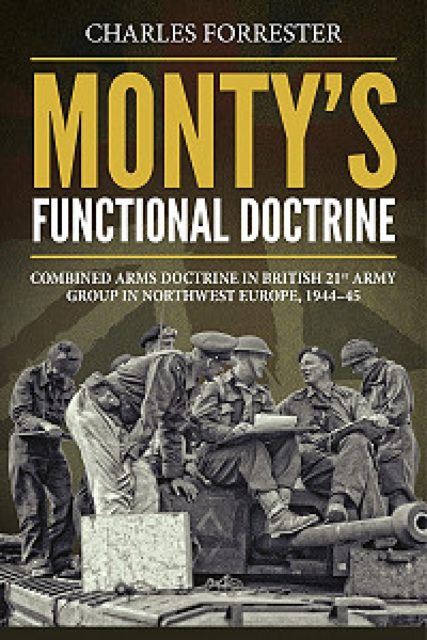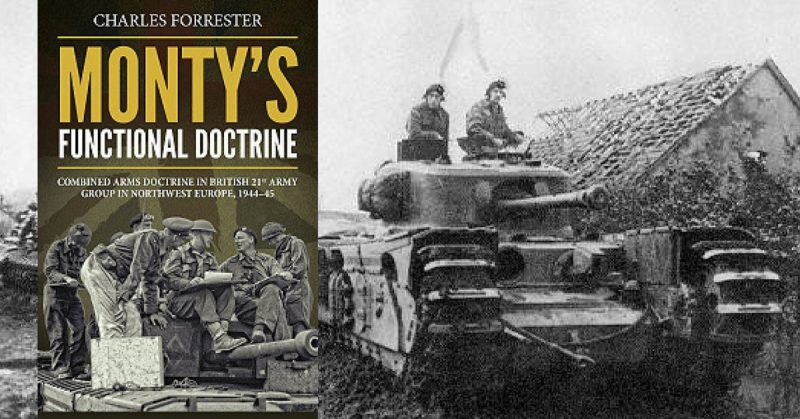Big name writers from Chester Wilmot onwards have offered up mixed opinions of the performance of British formations during the North-West Europe campaign of 1944-45. Events in Normandy dominate proceedings with examples of missed opportunities and full-on failure coloring impressions of what happened after the fall of Caen and the subsequent breakout period.
This book by Charles Forrester seeks to look deeply into how British armor integrated with other arms, and while he is no revisionist, he seeks to illustrate that events in Normandy were just one phase of the overall campaign. Hard lessons were learned and by 1945 the British were able to operate in a flexible and proactive manner belying the opinions anchored on Villers-Bocage and the investment of Caen.
Mr. Forrester shows the importance of looking back beyond the desert campaigns to the period between the two wars when the British Army establishment threw away all the hard-won dominance they held in armored operations. Happily, he refuses to get too bogged down in some of the throwaway lines from the pro-equine dinosaurs and looks instead at the middle ground where tanks were accommodated within a broader doctrine of progressive motorisation coupled with the firm split between cavalry and infantry tank formations.
There were visionaries, of course, and I am impressed with the author’s treatment of Fuller and Liddell-Hart. The latter’s rise to such pre-eminence continues to bewilder me a great deal, but life has taught much about how nonsense baffles brains. The man in the background throughout this book, however, was more than a theorist or commentator. He put his ideas into action, learned from mistakes and encouraged others to do the same.
I use in the background deliberately because the author completely avoids the well-worn railway sidings of Monty’s personality traits and all the negative aspects of his otherwise admirable career. This book is only interested in how Britain’s armor and infantry fought together, where successful tactical doctrine came from and how it mutated as the campaign in Europe progressed onto different ground and situations. The author describes Normandy as being a period of anarchy and explains how this came about.
The pre-war doctrine was set in place by the War Office and modified on the training grounds of the UK. Other experience came from North Africa and Italy. Monty himself had developed his own principles. All these elements came together in Normandy in what might have been the worst conditions for this to happen. Terrain, equipment, methodology and the Germans all had an impact on why things did not go very well at times and rapid solutions were needed to address the problems.
The Brits who came from North Africa suffered a rude shock when their previous hard-won experience met a totally different series of circumstances in the Bocage. Disappointment had to be countered by serious thinking. To his credit, Montgomery allowed his subordinates time to develop their own ideas within a framework he set which was ultimately shown to be flexible and successful. Unfortunately, not all the divisional and brigade commanders got the message, and some continued to follow clearly obsolete doctrinal instruction passed down from home or do things that had worked well in the desert. The only sand in Normandy was on the beaches.
What I like about the book is the way Mr. Forrester looks at the range of problems and sets them into context. The Normandy Bocage, the breakout, the advance across France and Belgium and the intense fighting in the Netherlands were very different phases requiring a range of methods to fight and win. A lot of histories tend to treat all these elements as if they were much the same, placing emphasis on personalities and comparisons with the American way of doing things.
By the time the British got into Germany and certainly once they were over the Rhine, the fighting was different again – more fragmented, diverse, desperate and confusing. Regardless of this, the armored formations had developed sound methods of how to work with infantry to support and protect each other; far away from the grand War Office visions of the 1930s when separating the two arms was in vogue (and thus unlearning almost everything Haig’s armies had developed in 1918).
Montgomery had built a framework that allowed the men leading the fight to think for themselves and be proactive. They were encouraged to mix and match continually mutating methods to fit the situations they were in. There was no use fighting battles in one place using redundant tactics from another.
But getting his message across was never straightforward even though Montgomery’s use of pamphlets and sand table exercises were always put together with his customary thoroughness. He used receptive people to promote best practice and supported the officers who were ‘on message’ and able to adapt their tactics to any situation.
While it is clear there were jealousies and tensions between individuals – as there was in every army – the overall result was one of broad understanding and ever-increasing excellence.
Monty called the shots and was prone to dominate his army commanders to an extent where they were often pushed aside at the map table. He sent home people who didn’t live up to expectations and promoted the men who bought into the ideas he expounded. The perpetual problem of decreasing manpower and the inferiority of particular weapons never left the campaign and in the case of infantry numbers things would get much worse by 1945. The British cut their cloth to suit and got on with things. They got the best out of their all Churchill and all Sherman formations and made good use of the Achilles and other self-propelled anti-tank weaponry in ways best suited to the conditions in front of them.
They adapted the roll of armoured recce regiments and made the most of the Cromwell, Firefly, and Challenger until the Comet made its belated and limited appearance in 1945. They knew their limitations in the face of increasingly fanatical resistance and qualitatively superior weapons but never avoided a fight.
While the book looks at 21st Army Group, it concentrates on British units and only brings in the Canadians when there was involvement in the overall planning by Canadian generals, notably Guy Simmonds, who Monty admired. The author only touches on the post-war battle of the memoirs and ownership of historiography at the very end of this absorbing and very informative book.
He eschews the touches of sensationalism found in popular histories and concentrates on his base in academia to write a balanced and convincing series of essays about how Montgomery developed the doctrine his subordinate commanders used in practice. This is the sort of book the authors whose names appear in a bigger font than the titles of their books have to read if they are to have any credibility.
Helion do quite a bit of this stuff. I’ve heard it described as dry and a bit serious, but this book will keep your interest thanks to the quality of both the writing and the arguments. As said, it is not revisionism painting Monty as some kind of mystic. The author explains what worked and what didn’t; who was on message and the others who were bowler hatted. Even the Hamilton books were able to show what a sound thinking man Monty was. His clarity of purpose and utter professionalism should never be in doubt. The less admirable aspects of his behaviour are for other books and authors.
This book shows what he and his army, corps, divisional and brigade commanders were able to achieve. There were tough lessons, failures, defeats and actually a great number of victories. The British did not get to the Baltic by chance. It wasn’t a fluke. This book will broaden your understanding of how that happened and perhaps it will enhance the reputation of an army some might see in this Olympic period as silver or even bronze medallists of 1945. They were golden, too.
Reviewed by Mark Barnes for War History Online.

MONTY’S FUNCTIONAL DOCTRINE
Combined Arms Doctrine in British 21st Army Group in Northwest Europe, 1944-45
By Charles Forrester
Helion & Company
ISBN: 978 1 910777 26 8
